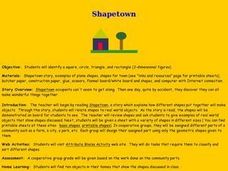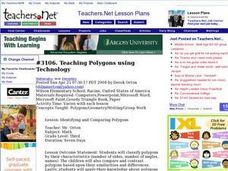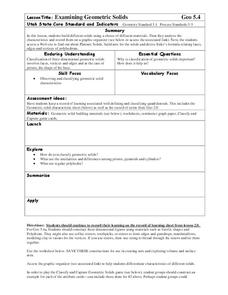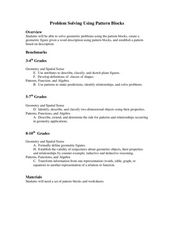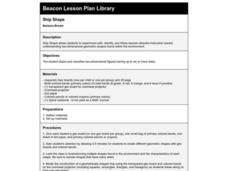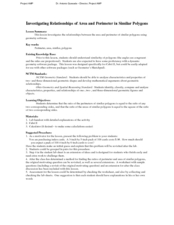Curated OER
A Planet Full of Animals
Pupils explore a variety of animals that live on our planet. The shapes, sizes, colors, movements, and coverings of the animals are observed. The similarities and differences in the animals are grouped according to common traits.
Curated OER
Mathematics in Art?
Fifth graders view prints of M.C. Escher's work. They look at examples of geometric figures and polygons and discuss places they have seen them. Students create their own tessellations. They write a report about the process they used in...
Curated OER
Classifying Polygons Worksheet
In this polygons worksheet, students write the name of the polygon, and if it is not a polygon they write "none". Students complete 9 problems.
Curated OER
Primary Geometry
Young scholars identity simple geometric shapes. In this early geometry lesson, the teacher introduces students to triangles, squares, and rectangles, then young scholars identify and classify the shapes as they are found in the...
Curated OER
2-D Polygons
Students investigate the concept of two dimensional polygons. They complete a vocabulary chart with the teacher or in independently. Students are shown various polygons in order to classify them and then asked to draw one of them from...
Curated OER
Math is Everywhere: Part 2
Second graders identify shapes and measurements in everyday life. In this measurement lesson, 2nd graders locate rectangles in their classroom and use standard and nonstandard forms to measure them. Students view a video clip...
Curated OER
Shape Detectives
Students become "shape detectives" as they identify, name, create and describe common shapes within pictures and objects found within the learning environment. Suggestions include incorporating shapes into all learning areas and daily...
Curated OER
Classifying Transformations
Students analyze different polygons by shapes and sides. In this geometry lesson plan, students differentiate between similar and congruent polygons. They name the different polygons based on the number of sides.
Curated OER
Shapetown
Students identify basic geometric shapes. In this geometry lesson plan, students read the book Shapetown and identify the various shapes from the story. Students are given a sheet and draw part of a town using only shapes.
Curated OER
It's Not All Greek to Me
Learners find out the meaning for prefixes used in math vocabulary. By dissecting words used in everyday math, they figure out what the prefix indicates and what the word means. A variety of well-organized worksheets and activities...
Curated OER
Teaching Polygons using Technology
Third graders utilize different types of computer programs, such as Microsoft paint and Microsoft Word to study and create different types of polygons. They use PowerPoint to create a story about a shape and others that it meets during a...
Shodor Education Foundation
An Introduction To Quadrilaterals
Young geometers investigate and apply properties of quadrilaterals. After a review and discussion of key terms, students use a computer applet to explore four-sided figures and classify them according to their attributes. The...
Curated OER
New Kids on the Block
Second graders identify and describe in their own language, the following 2-dimensional and 3-dimensional shapes: triangle, square, oblong (non-square rectangle), circle, oval, pentagon, hexagon, diamond, box, cylinder, and sphere. They...
Curated OER
Squares to Compare
Learners investigate how to draw and classify two and three dimensional figures (squares, triangles, rectangles.)
Curated OER
Examining Geometric Solids
Young scholars explore geometry by completing a math worksheet in class. In this shape identification lesson, students identify the characteristics associated with 15 solid geometric shapes. Young scholars identify patterns between...
Curated OER
Problem Solving Using Pattern Blocks
Learners use pattern blocks to create a figure that is described to them and establish a pattern based on the description of the geometric figure. In this pattern blocks lesson plan, students fill out shape and fraction worksheets.
Curated OER
Math: Shapes and More Shapes
Students locate lines of symmetry in regular polygons and predict the number of lines of symmetry in an octagon. In three different polygons, they construct all lines of symmetry and after making their prediction about the octagon,...
Curated OER
Ship Shape
Third graders experiment with, identify, and follow teacher-directed instruction toward understanding two-dimensional geometric shapes found within the environment. Groups of students utilize geoboards to help them explain geometric shapes.
Curated OER
Quadrilaterals and Other Polygons: Practice
In this polygons worksheet, students classify each polygon in as many was possible. Students then write polygon or not a polygon to classify each figure. Students find the measure of the missing angles and complete two test prep...
Curated OER
Quadrilaterals and Other Polygons: Homework
For this polygons worksheet, students classify each polygon in as many ways as possible. Students then write polygon or not a polygon to classify each figure and find the measure of the missing angles. Students finish with one word problem.
Curated OER
Regular Polygons
Fifth graders explore polygons. In this math lesson, 5th graders find examples of regular polygons in the classroom and measure the sides of figures to determine if they are regular polygons.
Curated OER
Investigating Area and Perimeter of Polygons.
Student sinvestigate the area and perimeter of polygons. They differentiate between similar and congruent polygons.. They identify the ratio and proportions of the sides and angles of polygons.
Curated OER
Opening A Cube
Fifth graders investigate mathematical concepts related to the construction of a three dimensional cube. They construct the cube from two dimensional patterns and compute the surface area. Students also define the faces, edges, and...
Curated OER
The Quirky Quadrilateral
Fourth graders identify and classify different triangles and quadrilaterals. Then they demonstrate an understanding of plane and solid geometric objects and use this knowledge to show relationships and solve specific problems. Students...










